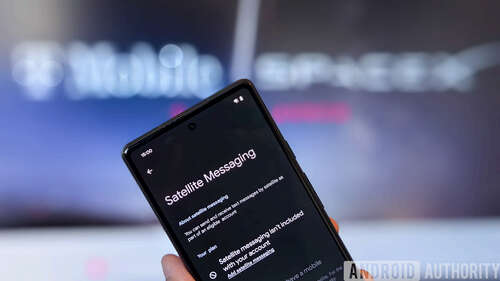Most people don’t consider the modem when considering buying a new phone, and why should they? Unfortunately, it’s something a lot of Pixel users are increasingly having to learn about. In recent years, connectivity issues have become one of the largest issues with the series. Thankfully, the situation has improved over the generations, and the upcoming Pixel 9 series will be better still.
Thanks to a Google insider, Android Authority has learned some of the modem upgrades coming to the Pixel 9 series, which brings some important upgrades, including satellite connectivity.
The importance of a better modem

Modems have been a known source of problems on Pixels since Google switched to its semi-custom Tensor chips back in 2021. Since the chips were developed in collaboration with Samsung’s S.LSI division, Google opted to use Exynos modems to simplify development, unlike previous Pixels, which used solutions from Qualcomm.
Unfortunately, the stability of the software running on the new modems was poor, especially at the beginning. In my personal experience using the Pixel 6, for example, I encountered cases where the modem would crash and even take other subsystems, such as sensors, offline with it! I certainly wasn’t alone in experiencing Pixel 6 connectivity issues.
Fortunately, as the new platform matured, the issues became rarer, especially after the Tensor G2 switched to a new modem — Exynos Modem 5300 (which is also used on the Pixel 8 series). The modem is less of an issue now than it used to be. However, it is worth mentioning that it’s still not perfect. For example, Pixel 7 and 8 users have reported problems since the March 2024 update. In our own recent survey, almost 60% of respondents reported encountering these issues!
A new modem that supports satellite connectivity is coming to the Pixel 9 series, next-gen Fold, and a 5G tablet.
The Tensor G4, coming first to the Pixel 9 series, is bringing a brand-new modem: the Samsung Modem 5400. While it’s not a Qualcomm modem like some would prefer, it’s still an upgrade over the previous generations. Our source couldn’t give any exact specs, but, as always, we can expect it to be faster and more power-efficient than the previous generations. Additionally, the software stack has been upgraded again, which should improve stability. Finally, there’s support for 3GPP Rel. 17 which brings support for 5G non-terrestrial networks (NTN), or satellite-based communication in other words.
The modem is coming to all cellular-enabled Tensor G4 devices, including the Pixel 9 series and the next-generation Pixel Fold. Our source has also informed us that Google is in the early stages of developing a 5G tablet, codename “clementine,” with the same modem. However, it is currently unknown when — and if — the device will make it to market.
| Exynos Modem 5123 | Exynos Modem 5300 | Exynos Modem 5400 | |
|---|---|---|---|
|
Paired with |
Exynos Modem 5123
Tensor (first generation) |
Exynos Modem 5300
Tensor G2, Tensor G3 |
Exynos Modem 5400
Tensor G4 |
|
Supported 5G spec |
Exynos Modem 5123
3GPP Release 15 |
Exynos Modem 5300
3GPP Release 16 |
Exynos Modem 5400
3GPP Release 17 |
|
Support for satellite connectivity |
Exynos Modem 5123
No |
Exynos Modem 5300
No |
Exynos Modem 5400
Yes |
|
Devices |
Exynos Modem 5123
Pixel 6 series, 6a |
Exynos Modem 5300
Pixel 7 series, 7a, 8 series, 8a, Pixel Fold |
Exynos Modem 5400
Pixel 9 series, next-generation Pixel Fold, future 5G tablet (“clementine”) |
Satellite connectivity for future Pixels

Mishaal Rahman / Android Authority
As we previously reported, Google has made significant progress in integrating support for satellite-based messaging in Android 15. Thanks to NTN support in the Exynos Modem 5400, the Pixel 9 series will be the first to support Android’s native satellite implementation.
Initially, the feature will be provided by T-Mobile (built in collaboration with SpaceX), with other providers possibly added in the future. The satellite link will allow for texting, but not calling. Additionally, a special “Satellite Gateway” app will allow for easy communications with emergency services via a feature called “Emergency SOS.”

The icon of the “Satellite Gateway” app
We’ve already seen earlier indicators about how this could work, but we can now preview it in more detail. First, you will be asked a few basic questions, to narrow down the situation. You will also be given a choice to notify your emergency contacts, after which you will be able to message with emergency services to get the help you need. Many of the questions will also have predefined answers to choose from to make the process quicker. We’ve listed some of the questions in the table below, to give a general idea of how it works.
| Questions |
|---|
|
What happened? |
|
[Are you/Are they/Is everyone] breathing? |
|
In total, how many people are [missing/trapped]? |
|
What best describes your situation? |
|
What is on fire? |
|
Are there weapons involved? |
|
What type of vehicle or vessel? |
|
Do any of these apply? |
Due to the nature of satellite connectivity, mobile solutions using it typically need very specific alignment to connect. Google has designed animations to help this process, such as the one below:
The satellite connectivity feature will also be available on the next-gen Pixel Fold, as indicated by the following message found in the app:
Code
To connect to the satellite, unfold your phone and rotate it %d degrees counter clockwiseStill not Qualcomm, but a welcome upgrade, regardless
While the modem upgrade we’re seeing here might not have been the significant upgrade we wanted, it will hopefully lead to fewer issues, which is obviously good to see. Especially since the Tensor G4 isn’t much more than a refreshed Tensor G3. It was only created because Google’s fully custom chip missed the deadline for 2024.

